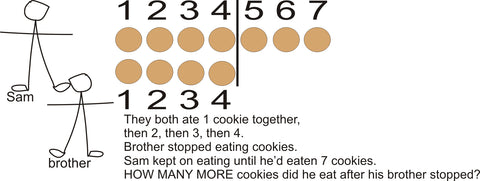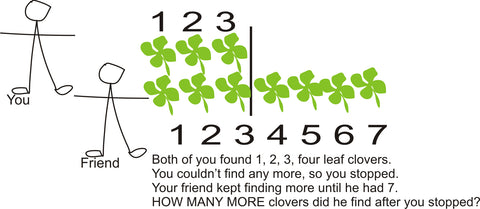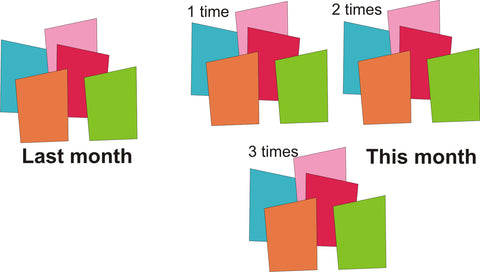
Tips for Helping Children Visualize Math Word Problems
Math word problems can be a real bear, especially for children who struggle with reading comprehension or for those learning to speak English as a second language. The good news is that there are a few strategies for helping to take the drudgery out of word problems. One is to help children develop the habit of visualizing, another is to group problems by type and identify words that are likely to be used in the problem, and the third is to help children learn to sketch out what is happening in the word problem.
Let’s look at some common terms used in word problems
“How many more…”
This type of problem is daunting to many students. The best way to handle it is to do several of these problems in a row until solving them becomes second nature to the kids. First of all, share with your students that when they hear the words, “how many more,” they can be sure that there are two numbers, and they were keeping up with each other evenly until the smaller one stopped. The other kept on going and got more than the first one.
Here are some examples for this type of problem:- “Sam ate 7 cookies while his brother ate 4. How many more cookies did Sam eat than his brother?”

- “You found 3 four leaf clovers. Your friend found 7. How many more did your friend find?”

For “how many more” problems, have your students draw a sketch like the ones in my examples. Have them draw a line showing where the smaller number stopped. Stress that up to the line, both were the same, but then one stopped and the other kept on going. The “how many more” is anything past the line.
Practice problems:
- “There were 5 robins in the pine tree and 7 in the oak tree. How many more robins were in the oak tree?”
- “In our class there are 12 girls and 17 boys. How many more boys are there than girls in the class?”
- “There are 4 yellow cars in my driveway and 2 green cars in my driveway. How many more yellow cars are there than green?”
After the children have made drawings for a few more of these problems, encourage them to close their eyes and see what is happening in the problem. This is best done with smaller numbers. Over time, they might begin to realize that the shortcut for this type of problem is to start with the larger of the two numbers and subtract the smaller number from it. However, just giving students a rule to memorize is not the best solution for those who learn most easily through visuals.
“Sharing”
Sharing problems use phrases like “You want to share equally with…” and “How many did each get?” Here are some examples of those problems:
- “Suzanna has 12 apples and wants to share them equally with her 3 friends. How many apples will each get?”

- “Four people are sharing 48 pennies. How many pennies will each person get?”
- “Five children buy 45 pieces of candy to share. How many pieces of candy will each child get?”
- “I have six dog cookies, and I have 2 dogs. I want to be fair and give each dog the same number of cookies. How many cookies will each dog get?”
- “John paid 35 cents for 5 candies. How much did each candy cost?”
Encourage your students to draw simple sketches to help them understand what is going on. Visualization will also greatly help in deciding what to do to solve the problem. Have the children close their eyes and make pictures in their minds of what you are saying.
For example, you might say, “Four people,” and the students will see four people in their minds. When you continue, saying, “are sharing 48 pennies,” have them imagine a pile of pennies on a table. Sharing means each person will get some, so at this point, ask the children how they would go about sharing the pennies equally and fairly among the 4 people.
An alternative to drawing is to supply little plastic bowls and pebbles for the children to use in acting out their sharing problem. Another option is to provide a large piece of paper on which the children can draw the correct number of circles to represent each person who is receiving an equal share, and then to draw little circles to represent the objects shared.
“Times” and “each has”
- “I see 3 cats outside, and each has four legs. How many legs are there in all?”
- “Jill picked 6 pears. Tom picked 4 times as many as Jill picked. How many pears did Tom pick?”

- “Mom baked cookies. She put the cookies into 5 little boxes. Each has 4 cookies in it. How many cookies are there in all?”
- "Last month Bev read 5 books. This month she read 3 times as many books. How many books did she read this month?”

There are two types of multiplication problems here. One is “how many are there in all?” and the other has to do with a number times. In both cases, drawing a sketch is going to be helpful. Of course, as before, have the students close their eyes and “see” the problem as you read it aloud, one detail at a time.
Here are some other problems to practice with:
- “I saw 10 bikes in front of the school. Each had two wheels. How many wheels were there in all?”
- “Last week Harry earned $2.00 doing chores. This week he earned 3 times that much raking leaves. How much money did he earn this week?”
“Away” and “more”
The minus sign we use in subtraction problems reminds me of a hand making a slashing motion, moving away from my body. In a word problem, it can help children signal the action in the problem.
For example, “There were 10 birds in the pine tree. 4 flew away. How many were left?” As you read the problem to your students, make the motion for away and make it replicate the look of the minus sign; palm open facing down, moving away from your body. Point out to the children that in this type of problem some went away or were lost, and so the result is that there are fewer left. You will take some away.
By contrast, when you talk about word problems that are reflecting the addition process, cross your arms and pull them towards your body as you say, “more.” Point out to the children that your crossed arms look a little like the plus sign. In these problems, you will start with a smaller number and wind up with a bigger number.
Here are some examples:
- “There were 3 children in the pool. In jumped 5 more. How many children are in the pool now?”
- “My friend had 12 quarters. She lost 5 of them on her way to the store. How many quarters did she have left?”
- “Mom had 15 cookies on a platter, ready to serve for dessert. When she went to get the tray, she saw that 4 of them were gone. How many cookies were left on the platter?”
- “I planted 4 rose bushes in my garden. The next week, I planted 8 more. How many rose bushes do I have now?”
- “We had 7 boys in our class at school. 3 of them moved away. How many boys are there now?”
Depending on the child, you could have them draw items, and then either add to them (addition) by drawing more, or cross some out for subtraction. You could also have them use real objects to make it easier and more fun. Always have the child visualize the action, however, in order to help him choose the appropriate action to take. For example, in the last problem above, you would say, “We had 7 boys in our class. Can you see 7 boys in your mind?” Next say, “3 of them moved away. Can you see those 3 boys walking out the door to go home or driving away in cars?” Next ask the child how he could show the action in that problem.
